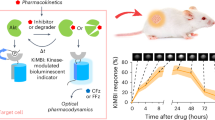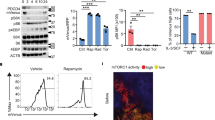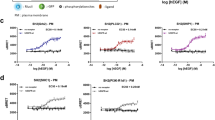Abstract
The serine/threonine kinase Akt mediates mitogenic and anti-apoptotic responses that result from activation of multiple signaling cascades. It is considered a key determinant of tumor aggressiveness and is a major target for anticancer drug development. Here, we describe a new reporter molecule whose bioluminescence activity within live cells and in mice can be used to measure Akt activity. Akt activity in cultured cells and tumor xenografts was monitored quantitatively and dynamically in response to activation or inhibition of receptor tyrosine kinase, inhibition of phosphoinositide 3-kinase, or direct inhibition of Akt. The results provide unique insights into the pharmacokinetics and pharmacodynamics of agents that modulate Akt activity, revealing the usefulness of this reporter for rapid dose and schedule optimization in the drug development process.
This is a preview of subscription content, access via your institution
Access options
Subscribe to this journal
Receive 12 print issues and online access
$209.00 per year
only $17.42 per issue
Buy this article
- Purchase on SpringerLink
- Instant access to full article PDF
Prices may be subject to local taxes which are calculated during checkout




Similar content being viewed by others
References
Lemmon, M.A. & Schlessinger, J. Regulation of signal transduction and signal diversity by receptor oligomerization. Trends Biochem. Sci. 19, 459–463 (1994).
Romashkova, J.A. & Makarov, S.S. NF-κB is a target of AKT in anti-apoptotic PDGF signalling. Nature 401, 86–90 (1999).
Brunn, G.J. et al. Direct inhibition of the signaling functions of the mammalian target of rapamycin by the phosphoinositide 3-kinase inhibitors, wortmannin and LY294002. Embo J. 15, 5256–5267 (1996).
Sarbassov, D.D., Guertin, D.A., Ali, S.M. & Sabatini, D.M. Phosphorylation and regulation of Akt/PKB by the rictor-mTOR complex. Science 307, 1098–1101 (2005).
Brunet, A. et al. Akt promotes cell survival by phosphorylating and inhibiting a Forkhead transcription factor. Cell 96, 857–868 (1999).
Zha, J., Harada, H., Yang, E., Jockel, J. & Korsmeyer, S.J. Serine phosphorylation of death agonist BAD in response to survival factor results in binding to 14-3-3 not BCL-X(L). Cell 87, 619–628 (1996).
Cross, D.A., Alessi, D.R., Cohen, P., Andjelkovich, M. & Hemmings, B.A. Inhibition of glycogen synthase kinase-3 by insulin mediated by protein kinase B. Nature 378, 785–789 (1995).
Mayo, L.D. & Donner, D.B. A phosphatidylinositol 3-kinase/Akt pathway promotes translocation of Mdm2 from the cytoplasm to the nucleus. Proc. Natl. Acad. Sci. USA 98, 11598–11603 (2001).
Vivanco, I. & Sawyers, C.L. The phosphatidylinositol 3-kinase AKT pathway in human cancer. Nat. Rev. Cancer 2, 489–501 (2002).
Chen, X. et al. Constitutively active Akt is an important regulator of TRAIL sensitivity in prostate cancer. Oncogene 20, 6073–6083 (2001).
Hennessy, B.T., Smith, D.L., Ram, P.T., Lu, Y. & Mills, G.B. Exploiting the PI3K/AKT pathway for cancer drug discovery. Nat. Rev. Drug Discov. 4, 988–1004 (2005).
Rosenzweig, K.E., Youmell, M.B., Palayoor, S.T. & Price, B.D. Radiosensitization of human tumor cells by the phosphatidylinositol 3-kinase inhibitors wortmannin and LY294002 correlates with inhibition of DNA-dependent protein kinase and prolonged G2-M delay. Clin. Cancer Res. 3, 1149–1156 (1997).
Hu, L., Zaloudek, C., Mills, G.B., Gray, J. & Jaffe, R.B. In vivo and in vitro ovarian carcinoma growth inhibition by a phosphatidylinositol 3-kinase inhibitor (LY294002). Clin. Cancer Res. 6, 880–886 (2000).
Knight, Z.A. et al. Isoform-specific phosphoinositide 3-kinase inhibitors from an arylmorpholine scaffold. Bioorg. Med. Chem. 12, 4749–4759 (2004).
DeFeo-Jones, D. et al. Tumor cell sensitization to apoptotic stimuli by selective inhibition of specific Akt/PKB family members. Mol. Cancer Ther. 4, 271–279 (2005).
Kondapaka, S.B., Singh, S.S., Dasmahapatra, G.P., Sausville, E.A. & Roy, K.K. Perifosine, a novel alkylphospholipid, inhibits protein kinase B activation. Mol. Cancer Ther. 2, 1093–1103 (2003).
Yang, L. et al. Akt/protein kinase B signaling inhibitor-2, a selective small molecule inhibitor of Akt signaling with antitumor activity in cancer cells overexpressing Akt. Cancer Res. 64, 4394–4399 (2004).
Beckmann, N., Mueggler, T., Allegrini, P.R., Laurent, D. & Rudin, M. From anatomy to the target: contributions of magnetic resonance imaging to preclinical pharmaceutical research. Anat. Rec. 265, 85–100 (2001).
Chenevert, T.L. et al. Diffusion magnetic resonance imaging: an early surrogate marker of therapeutic efficacy in brain tumors. J. Natl. Cancer Inst. 92, 2029–2036 (2000).
Moffat, B.A. et al. Diffusion imaging for evaluation of tumor therapies in preclinical animal models. Magma 17, 249–259 (2004).
Yaffe, M.B. et al. A motif-based profile scanning approach for genome-wide prediction of signaling pathways. Nat. Biotechnol. 19, 348–353 (2001).
Durocher, D. & Jackson, S.P. The FHA domain. FEBS Lett. 513, 58–66 (2002).
Luker, K.E. et al. Kinetics of regulated protein-protein interactions revealed with firefly luciferase complementation imaging in cells and living animals. Proc. Natl. Acad. Sci. USA 101, 12288–12293 (2004).
Amann, J. et al. Aberrant epidermal growth factor receptor signaling and enhanced sensitivity to EGFR inhibitors in lung cancer. Cancer Res. 65, 226–235 (2005).
Vink, S.R., Schellens, J.H., van Blitterswijk, W.J. & Verheij, M. Tumor and normal tissue pharmacokinetics of perifosine, an oral anti-cancer alkylphospholipid. Invest. New Drugs 23, 279–286 (2005).
Zhang, J., Ma, Y., Taylor, S.S. & Tsien, R.Y. Genetically encoded reporters of protein kinase A activity reveal impact of substrate tethering. Proc. Natl. Acad. Sci. USA 98, 14997–15002 (2001).
Violin, J.D., Zhang, J., Tsien, R.Y. & Newton, A.C. A genetically encoded fluorescent reporter reveals oscillatory phosphorylation by protein kinase C. J. Cell Biol. 161, 899–909 (2003).
Kunkel, M.T., Ni, Q., Tsien, R.Y., Zhang, J. & Newton, A.C. Spatio-temporal dynamics of protein kinase B/Akt signaling revealed by a genetically encoded fluorescent reporter. J. Biol. Chem. 280, 5581–5587 (2005).
Ozawa, T., Kaihara, A., Sato, M., Tachihara, K. & Umezawa, Y. Split luciferase as an optical probe for detecting protein-protein interactions in mammalian cells based on protein splicing. Anal. Chem. 73, 2516–2521 (2001).
Chen, G. et al. Phosphorylated FADD induces NF-κB, perturbs cell cycle, and is associated with poor outcome in lung adenocarcinomas. Proc. Natl. Acad. Sci. USA 102, 12507–12512 (2005).
Acknowledgements
We thank members of the Center for Molecular Imaging and the Department of Radiation Oncology at the University of Michigan for their help and support. We thank Genentech for erlotinib. This work was supported by US National Institutes of Health grants P01CA85878, P50CA01014 and R24CA83099.
Author information
Authors and Affiliations
Contributions
L.Z. conducted the majority of the experiments, with help from K.C.L. (in vivo studies), M.S.B., A.P.K. and A.S. (in vitro studies). E.C.H. and B.D.R. provided routine guidance; A.R. supervised the project and wrote the manuscript.
Corresponding author
Ethics declarations
Competing interests
The authors declare no competing financial interests.
Rights and permissions
About this article
Cite this article
Zhang, L., Lee, K., Bhojani, M. et al. Molecular imaging of Akt kinase activity. Nat Med 13, 1114–1119 (2007). https://doi.org/10.1038/nm1608
Received:
Accepted:
Published:
Issue Date:
DOI: https://doi.org/10.1038/nm1608



